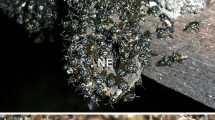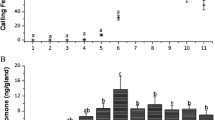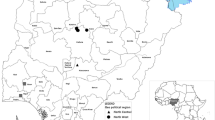Abstract
Males of the carpenter bee,Xylocopa sulcatipes, establish and defend territories which they mark with the secretions of their mandibular glands. Chemical analysis of the glandular blend revealed that it is composed of guaiacol,p-cresol, and vanillin. Territorial males recognize other intruding males either by sight or by the odor emitted from their mandibular glands. They chase the intruder out of the territory immediately, but will not do so if the visitor is a female. If a female, however, is scented with the reconstituted synthetic pheromonal blend and introduced into a territory of a male, it is treated as a male and chased out of the territory. It is suggested that the blend has a dual function: Guaiacol seems to be the aggressiveness elicitor, while vanillin is the territorial marker and female attractant and therefore could be considered a sex pheromone.
Similar content being viewed by others
References
Alcock, J. 1978. Notes on male-locating behavior in some bees and wasps of Arizona.Pan-Pac. Entomol. 54:215–225.
Alcock, J. 1980. Natural selection and the mating system of solitary bees.Am. Sci. 68:146–153.
Bergstrom, G., andSvennson, G. 1973. 2,3-Dihydro-6-trans-farnesol: Main component in the cephalic marker secretion ofBombus jonellus K. (Hym., Apidae) males. Zool.Suppl. 1:61–65.
Borg-Karlson, A.K., andTengo, J. 1980. Pyrazines as marking volatiles in philanthine and nyssonine wasps (Hymenopera: Sphecidae).J. Chem. Ecol. 6:827–835.
Frankie, G.W., Vinson, S.B., andCoville, R.E. 1980. Territorial behavior ofCentris adani and its reproductive function in the Costa Rican dry forest (Hymenoptera: Anthophoridae).J. Kans. Entomol Soc. 53:834–857.
Gerling, D., andHermann, H.R. 1978. Biology and mating behavior ofXylocopa virginica L. (Hymenoptera, Anthophoridae).Behav. Ecol. Sociobiol. 3:99–111.
Gerling, D., Hurd, P.D.,andHefetz, A. 1983. Comparative behavioral biology of two Middle East species of carpenter bees (Xylocopa Latreille) (Hymenoptera: Apoidea).Smilhsonian Contrib. Zool. 369:1–33.
Linsley, E.G. 1965. Notes on male territorial behavior in the Galapagos carpenter bee (Hymenoptera: Apidae)Pan-Pac.Entomol. 41:158–161.
Simon Thomas, R.T., andPoorter, E.P.R. 1972. Notes on the behavior of malesPhilanthus triangulum (F.) (Hymenoptera).Tidj. Enlomol. 115:141–151.
Velthuis, H.H.W.,andGerling, D. 1980. Observation on territoriality and mating behavior of the carpenter beeXylocopa sulcatipes.Entomol. Exp. Appl. 28:82–91.
Velthuis, H.H.W.,andCamargo, J.M.F. 1975a. Observations on male territories in a carpenter bee,Xylocopa (Neoxylocopa) hirsutissima Maidl (Hymenoptera,Anthophoridae). Z.Tierpsychol. 38:409–418.
Velthuis, H.H.W., andCamargo, J.M.F. 1975b. Further observations on the function of male territories in the carpenter beeXylocopa (Neoxvlocopa) hirsutissima (Maidl) (Anthophoridae, Hymenoptera).Neth. J. Zool. 25:516–528.
Vinson, S.B., Williams, K.J., Frankie, G. W., Wheeler, J.W., Blum, M.S., andCoville, R.E. 1982. Mandibular glands of maleCentris adani (Hymenoptera; Anthophoridae): Their morphology, chemical constituents and function in scent marking and territorial behavior.J. Chem. Ecol. 8:319–327.
Wheeler, J.W., Evans, S.L., Blum, M.S., Velthuis, H.H.W., andCamargo, J.M.F. 1976.cis-2-Methyl-5-hydroxyhexanoic acid lactone in the mandibular gland secretions of a carpenter bee.Tetrahedron Lett. 45:4029–4032.
Author information
Authors and Affiliations
Rights and permissions
About this article
Cite this article
Hefetz, A. Function of secretion of mandibular gland of male in territorial behavior ofXylocopa sulcatipes (Hymenoptera: Anthophoridae). J Chem Ecol 9, 923–931 (1983). https://doi.org/10.1007/BF00987815
Received:
Revised:
Issue Date:
DOI: https://doi.org/10.1007/BF00987815




